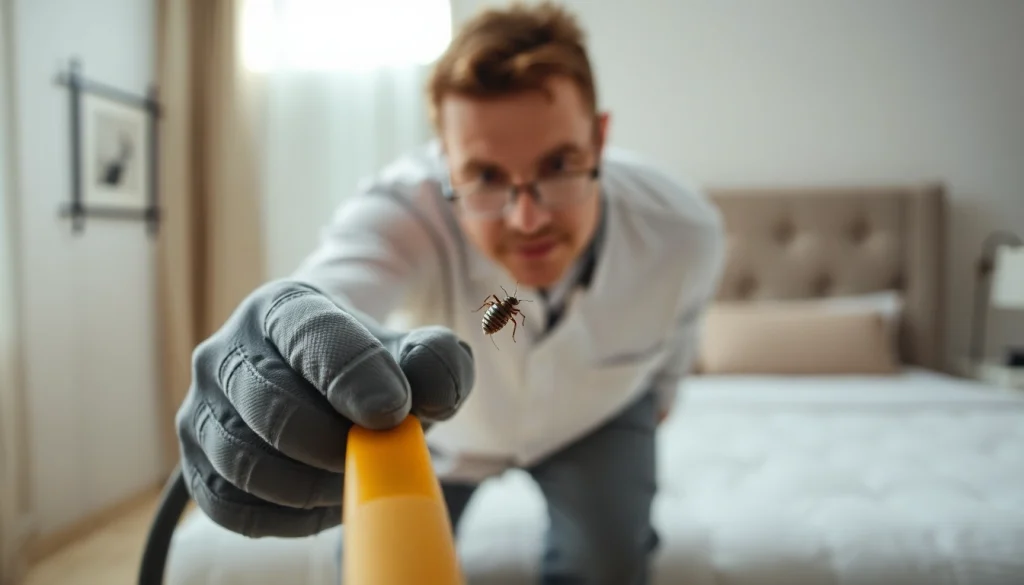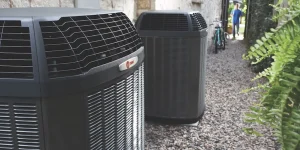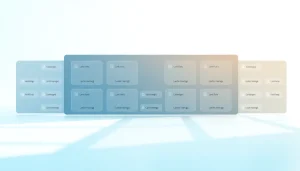Effective Strategies for Bed Bug Removal: Your Comprehensive Guide

Understanding Bed Bugs
Bed bugs are small, elusive pests that can turn a comfortable home into an uncomfortable nightmare. Knowing how to identify an infestation and understanding their behavior is critical for effective Bed bug removal. This section covers how to spot these pests, recognize the signs of a bite, and learn about their life cycle.
Identifying Bed Bug Infestations
Identifying a bed bug infestation can be tricky due to their small size and nocturnal habits. Bed bugs are typically brown, flat, and can be as small as an apple seed. They hide in cracks and crevices during the day, making early detection difficult. To identify an infestation, look for:
- Live bed bugs or discarded exoskeletons in sleeping areas.
- Reddish-brown stains on sheets or mattresses, often a result of bed bug excrement or crushed bugs.
- Small white eggs and eggshells in hiding spots.
- Unpleasant, musty odors in heavily infested areas.
Regular inspections of sleeping areas can help catch infestations early, allowing for more effective treatments.
Common Symptoms of Bed Bug Bites
Bed bug bites can be mistaken for other insect bites, so awareness of the symptoms is essential. The most common indicators include:
- Red, itchy welts or bumps on the skin, often in a linear or cluster pattern.
- Swelling and inflammation around the bite area.
- Severe itching that can lead to secondary infections due to scratching.
Some individuals may not react to bed bug bites immediately, or may develop sensitivity over time, illustrating the importance of understanding one’s own body and reactions.
Life Cycle and Behavior of Bed Bugs
Understanding the life cycle of bed bugs is crucial in tackling their removal. Bed bugs go through several stages:
- Eggs: Females can lay 1-5 eggs per day, with a total of up to 500 during their lifetime.
- Nymphs: These are juvenile bugs that go through five molts before becoming adults. They require a blood meal at each stage to continue development.
- Adults: Mature bed bugs can live several months without feeding, making them resilient pests that can survive unnoticed for extended periods.
Bed bugs are primarily active at night and feed on human blood, utilizing their elongated beaks to pierce the skin and withdraw blood. Their ability to hide makes them particularly challenging to eradicate.
Methods of Bed Bug Removal
When it comes to removing bed bugs, there are several effective techniques available. Each method ranges in complexity and effectiveness, depending on the severity of the infestation.
Heat Treatment for Bed Bugs
Heat treatment is one of the most effective methods for eradicating bed bugs. This technique involves heating an infested space to temperatures that are lethal to bed bugs and their eggs, typically around 113°F (45°C) for an extended period. Here’s how it works:
- Prepare your home by removing items that may block airflow and heat penetration.
- Utilize specialized heating equipment, which can be used to raise room temperatures quickly.
- Monitor temperatures carefully, ensuring that every area reaches the necessary temperature for effective treatment.
Heat treatment is chemical-free and poses minimal risk to the environment when done correctly. It is also effective at treating multiple areas at once, making it a preferred choice for severe infestations.
Chemical Methods of Exterminating Bed Bugs
Chemical treatments are another option for bed bug removal, often employing insecticides that specifically target their life cycle. When opting for chemical solutions, consider the following:
- Insecticides come in various forms, including sprays, dusts, and foggers. Choose products labeled for bed bugs specifically.
- Follow all manufacturer instructions carefully to ensure safety and effectiveness.
- Consider rotating different types of insecticides to reduce the risk of bed bug resistance.
While chemical treatments can be effective, they are generally best used in conjunction with other methods, like heat treatment, for complete eradication.
DIY Techniques for Bed Bug Removal
For those who prefer do-it-yourself methods, several techniques can be employed to tackle bed bug infestations, albeit usually best for mild cases. These include:
- Steam Cleaning: High-temperature steam can kill bed bugs on contact. Focus on seams, folds, and crevices.
- Vacuuming: Regular vacuuming of living areas, particularly mattresses and bedding, helps reduce bed bug populations. Be sure to dispose of the vacuum bag promptly.
- Sealing Cracks and Crevices: Use caulk to seal entry points where bed bugs may hide, reducing habitat and potential nesting areas.
While these methods can be useful, they often lack the thoroughness of professional treatments and may only serve as stop-gap measures.
Preventing Future Bed Bug Infestations
Prevention is key in maintaining a bed bug-free environment. Taking proactive measures can significantly reduce the chances of a future infestation.
Tips for Travelers to Avoid Bed Bugs
Traveling can introduce bed bugs into your home if precautions aren’t taken. Here are some strategies for preventing bed bugs while on the go:
- Inspect hotel rooms upon arrival, focusing on mattresses and furniture for signs of bed bugs.
- Use hard-shell luggage whenever possible, which is less likely to harbor bugs compared to fabric bags.
- Store luggage on racks or in the bathroom, away from potential bug hiding spots like beds or sofas.
Taking these steps can greatly reduce the likelihood of transporting bed bugs back home.
Home Maintenance to Deter Bed Bugs
Regular home maintenance is essential to deter bed bugs. Implement these practices:
- Regularly wash and dry bedding and clothing on high heat, as heat can kill any hidden bugs.
- Keep your home clutter-free to reduce hiding spots.
- Conduct regular inspections of critical areas and use mattress and box spring encasements, which serve as barriers against bed bugs.
Keeping a clean, organized living space makes it far less likely that bed bugs will take up residence in your home.
Using Bed Bug Monitors Effectively
Bed bug monitors can serve as an early warning system if you are concerned about potential infestations. Implement these practices:
- Place monitors near beds, couches, and other furniture that may host bed bugs.
- Check the monitors regularly for activity, and take action immediately if bugs are detected.
- Use both passive monitors, which lure bugs in, and active monitors, which capture them.
These tools can provide peace of mind and help catch an infestation before it becomes severe.
Costs Involved in Bed Bug Removal
The costs associated with bed bug removal can vary widely based on several factors. Understanding these can help you budget effectively and choose the best treatment option.
Factors Influencing Treatment Costs
Several factors contribute to the costs associated with bed bug removal:
- Infestation Size: Larger infestations will typically require more comprehensive treatments, driving up costs.
- Type of Treatment: Heat treatments may be more expensive upfront but can often eradicate infestations in a single session.
- Location: Treatment costs can vary by geographic region, with urban areas generally seeing higher prices.
Taking these factors into account ensures that you will be adequately prepared for the financial outlay required for effective removal.
Comparing DIY vs Professional Services
When considering Bed bug removal, determining whether to go the DIY route or hire professional services is an important consideration:
- DIY methods may be less expensive initially, but they often lack the thoroughness and effectiveness of professional treatments.
- Professionals typically come equipped with advanced tools, such as high-heat machines and specialized insecticides, ensuring a higher success rate.
- For severe infestations, professional services can save time and provide peace of mind, knowing the job is handled properly.
Ultimately, the choice will depend on your specific circumstances and level of comfort with DIY methods.
Budget-Friendly Solutions for Bed Bug Issues
If you are dealing with a bed bug problem on a budget, consider these cost-effective strategies:
- Take advantage of natural remedies, such as diatomaceous earth, which can effectively kill bed bugs without harmful chemicals.
- Engage in consistent preventative practices, which can significantly delay or prevent the onset of bed bugs.
- Partner with neighbors for bulk treatments, which can reduce individual costs while maximizing effectiveness.
By remaining proactive and utilizing budget-friendly solutions, you can effectively manage and mitigate bed bug concerns.
Aftercare and Monitoring
After treatment has been completed, ongoing monitoring and maintenance are crucial to ensure bed bugs do not return. Here are some strategies for effective aftercare:
Follow-Up Procedures Post-Treatment
Following up after bed bug treatment is essential to watch for any potential return of these pests. Key procedures include:
- Conducting spot checks on mattresses and furniture regularly, especially within the first few months post-treatment.
- Using bed bug monitors as an ongoing strategy to capture any remaining bugs or new arrivals.
- Maintaining cleanliness by frequently washing and drying bedding and vacuuming living spaces.
Proactive aftercare can significantly reduce the chance of re-infestation.
Signs to Watch Post Bed Bug Removal
Even after an infestation has been treated, vigilance is crucial. Be wary of:
- New bite marks appearing on skin, especially during the night.
- Return of stains or odors indicative of bed bugs.
- Reappearance of live bugs or new exoskeletons.
If any of these signs arise, immediate action should be taken to address potential reinfestation before it escalates.
When to Seek Professional Help Again
In case of re-infestation, it may be necessary to call in professional help again. Signs indicating the need for professional intervention include:
- Persistent or worsening bite marks despite treatment.
- Failed DIY solutions after multiple attempts.
- A rapid increase in sightings or signs of bed bugs.
Professional exterminators can offer solutions that may not be available through DIY methods, ensuring that the problem is fully addressed.







